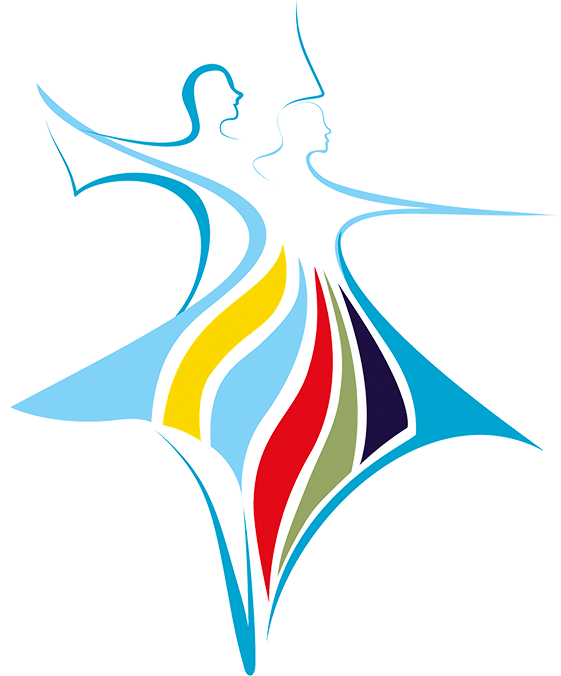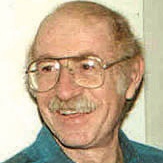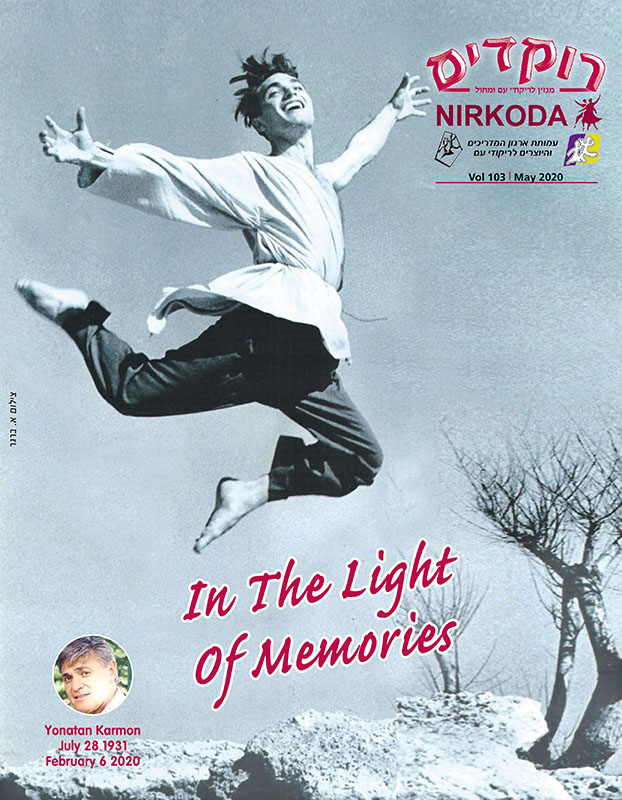- Home
- Rokdim Nirkoda 103
- From Dance Suites for the Stage To Dance Sessions for Everyone
From Dance Suites for the Stage To Dance Sessions for Everyone
Karmon's stage dances become folk dances
- Translation: Ruth Goodman
I met Yonatan Karmon in the mid 1950’s at Café Kassit in Tel Aviv. In those days, Yoav and Mira Ashriel were the choreographers of the Hapoel Tel Aviv performing group in which I was a dancer. When we met Karmon at Kassit, Yonatan was beginning to organize a group comprised of the best dancers in Israel. That group became Ha’Lehaka Ha’Merkazit (The Central Performing Troupe) of the Misrad LeChinuch Ve’Tarbut (Department of Education and Culture) of the Histadrut, which was then under the direction of Tirtza Hodes. Yonatan asked me to join the Lehaka and I was delighted to accept his invitation. I will never forget my first rehearsal. During the warm ups, the group was doing classical ballet chaînés turns (quick spinning turns on both feet) from corner to corner of the room. The trained dancers were comfortable with spotting so they didn’t lose their balance, but those of us without the classical ballet training ended up all over the room! With time, Yonatan brought us to the level where we were able to execute the turns comfortably. This was one of Karmon’s great talents – he was able to recognize the raw ability of natural dancers without the trained technique and bring them to a high level of performance without losing their inherent sense of dance, i.e., Yonatan was able to blend technical and natural qualities in his dancers that created a uniquely spontaneous spirit that captivated audiences. Whether we came from a professional or amateur background, he expected us to rehearse as professionals and to focus on his every move. To emphasize this point, when Yonatan introduced Haroa Haktana as part of a Shepherd Dance Suite, one of the dancers asked Yonatan, “Which foot do we start with”? Yonatan replied, “Sit down” and he then asked for another dancer to take his place stating that “If you want to dance with us, you need to know how to follow my movements”.
In the late 1950s, a lead ballet dancer, Y. Mashiach, who had performed in the Israeli Opera, was in a car accident which unfortunately resulted in his having one of his legs amputated. Many of the theatrical performers in Israel – singers, dancers, actors – decided to hold a benefit performance for him in the Ziratron (a large amphitheater) in Ramat Gan and Ha’Lehaka Ha’Merkazit was invited to be part of the performance. This was the debut performance of Ha’Lehaka Ha’Merkazit and we presented a suite of dances choreographed by Karmon comprised of “Mi Yivne Bayit, Yamin U’Smol (Orcha Bamidbar) and Al Tira”. This medley became one of the best known stage dances and it was adapted by many performing groups around the world. The more elaborate form of costumes and the long ponytail hairstyle of the girls became the identifying signature of all Israeli folk dance performing troupes everywhere. After the benefit performance concluded, two journalists came back stage to make sure that we were indeed Israelis because our energy and spirit were so outstanding.
After some time, when Yoav and Mira left Hapoel Tel Aviv, I took over the Open Sessions and performing group. I asked Yonatan to choreograph for the performing group. He accepted and prepared several new dance suites. In 1960, the group was invited to perform in Cyprus – the first amateur Israeli dance group to perform there.
During the time that I took over the sessions of Hapoel Tel Aviv, I decided to introduce three of the Karmon dances that I adapted from our performing suites: “Haroa Haktana” and “Al Tira” – circle dances, and “Yamin U’smol” (Orcha Bamidbar) – a partner dance. These dances were enthusiastically received when first introduced more than 60 years ago and to this day, they are still danced in sessions throughout the world, despite the initial resistance from some traditionalists to the change in the style of recreational Israeli folk dances. Well, the rest is history!
When I left Israel in 1961, Yonatan Gabay z”l, who also performed in Halehaka Hamerkazit, decided to introduce some of these adapted Karmon folk dances in Haifa as well.
When I arrived in the United States (in 1961) and began to give workshops in New York, I introduced nine additional Karmon dances adapted from the performance medleys: a circle dance – “Nad Ilan”; and eight partner dances – “Israeli Mazurka”, “Shibolet Basadeh”, “Gozi Li”, “Elem VeSusato”, “Me’Emek Legivah” (Shtu Ha’Adarim), “Mi Yivneh Bayit”, “Mechol Hakerem” and “Shiru Hashir”. In total, there were twelve adapted Karmon dances that I introduced into the Israeli folk dance repertoire.
In 2005, as part of a special tribute to me at Hilulim Dance Camp in New York, Gadi Bitton surprised me by inviting Yonatan to come from Israel to celebrate with me. It was personally very emotional, and when Yonatan was introduced on the dance floor at the camp, we hugged each other and I was choked up with tears in my eyes. This is a moment that I will never forget. Yonatan Karmon really changed my life. He molded me as a dancer with the passion to enjoy dancing and to spread the joyful, energetic spirt that defined him. He personally encouraged me to always be better and better, especially when I lacked confidence – and he was successful! Thank you, Yonatan for the special gift that you gave to me and to so many others in the dance world.









Comments
התראות